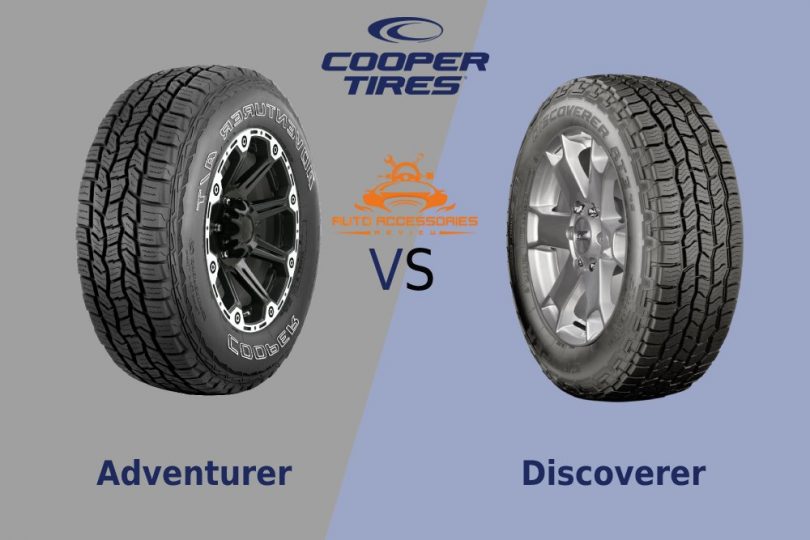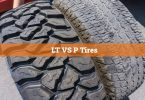The use of all-terrain tires is common on multiple vehicles. While Cooper’s Adventurer and Discoverer are very similar in many ways, there are some differences you can’t ignore.
Here we’ll look at how exactly they differ and what might be the best choice for your car.
Cooper Adventurer
Pros
- Good traction on wet and dry pavement
- Comfortable and smooth ride
- Terrific off-road traction
Cons
- Questionable tread longevity
- Lacks traction on snow
- Doesn’t do well in deep mud
Cooper Discoverer
Pros
- Ride comfort and noiselessness are outstanding
- Superb traction on wet and dry pavement
- Supreme traction on rocky terrain
- Higher priced tires of the two
Cons
- Road grip when cornering could be better
- Lack of stability
Cooper Adventurer vs Discoverer: How Do They Differ?

1. Comfort
-
Adventurer
The open tire design offers less traction and makes the ride less cushioned. Pair that with the louder cab, and the ride’s comfort is less than stellar.
-
Discoverer
Improved high patch contact offers better traction, resulting in a smooth ride. Paired with the noiseless cab makes for a very comfortable ride.
-
Winner
Discover’s very comfortable ride is the winner.
2. Maneuverability
Both tires provide stability, traction, and road grip. There is no significant difference in maneuverability, making it a tie.
3. On-road traction
-
Adventurer
Because of the lower patch contact, the Cooper Adventurer does great on dry pavement but not as well as the discoverer. There are times the ride may feel wobbly.
-
Discoverer
Known for its thick treads, the Discoverer grips the road with high patch traction offering control while steering resulting from its superb traction.
-
Winner
Discoverer has better traction overall, winning this category.
4. On-road & off-road driving
On-road
- Adventurer
The Adventurer offers superb road grip but is not as firm on the road as the Discoverer.
- Discoverer
The Discoverer offers outstanding grip on the road, especially in wet conditions.
- Winner
The winner here is the Discoverer with its superior road grip.
Off-road
- Adventurer
The tread block design of the Adventurer grips rocky terrain and hard-graveled surfaces tremendously.
- Discoverer
While the Discoverer does well on rocky terrain, it falls short compared to the Adventurer.
- Winner
The Adventurer’s tread block design climbs to the top with this one.
5. Drivability on dry pavement
-
Adventurer
Excellent traction on dry pavement offers a smooth drive.
-
Discoverer
The Discoverer’s superb traction allows smooth driveability in all weather and does best on dry pavement.
-
Winner
The Discoverer’s smoother driveability on dry pavement wins in this case.
6. Wet drivability
-
Adventure
In wet and rainy weather, the Adventurer steers well. It has a greater amount of siping and wide lugs, which undoubtedly accounts for this.
-
Discoverer
Its deep voids and zigzag sipes remove roadway water and maintain traction in wet weather to avoid slipping off the road.
-
Winner
The ability to stay on the road and avoid slipping in the rain, plus the shoulder scoops, sipes, and lateral grooves, work together to win this.
7. Snow drivability
-
Adventurer
Despite its excellent road grip on rocky terrain, the Adventurer offers a slippery ride on the snow, making driving questionable.
-
Discoverer
Discover’s 3PMSF rating as a snow tire offers superior handling in snowy conditions.
-
Winner
The Discoverer, with a 3PMSF rating as a snow tire and superior traction on snowy roads, is the undisputed winner.
8. In-cab noise
-
Adventurer
The tire’s wide, deep grooves have lots of room for air particles to move about, creating a much nosier cab than the Discoverer.
-
Discoverer
The tight grooves on the tire leave little room for air particles to create noise. Also, the circulation of sound is lower due to the shoulder lugs’ smaller tie bars, resulting in a quieter ride.
-
Winner
The Discoverer wins based on less cab noise.
9. Treads
-
Adventurer
Its sipes and deep treads do well preventing hydroplaning but have less contact patch than its counterpart. The low contact patch increases the tread life of the Adventurer.
-
Discoverer
The bulky, high treads and high contact patch give excellent tire grip and matching traction. While this may affect the tires’ tread life, the Discoverer comes with a tread-life warranty
-
Winner
The high contact patch and terrific grip and traction win this category for the Discoverer. The tread-life warranty is icing on the cake for this tire!
10. Durability
-
Adventurer
The enhanced rubber of the Adventurer has a silica-based casing to reinforce its steel belts. Both maintain their longevity and help it withstand chips and scratches like the Discoverer. But unfortunately, its sidewalls are not so durable and can crack or obtain scratches.
-
Discoverer
The tire has a 2-ply casing consisting of a polyester compound with twin belts strengthened with high steel that contain nylon casting. The Even Wear Arc’s slower wearing technology throws out the stones and is scratch-and chip-resistant.
-
Winner
Discoverer wins with its 2-ply casing and better tread technology that makes it more durable.
11. Warranty
-
Adventurer
Cooper offers no tread-life warranty on its Adventurer tires.
-
Discoverer
There is a 60,000-mile tread-life warranty.
-
Winner
Discoverer’s 60,000-mile tread-life warranty wins this category.
12. Price
-
Adventurer
The price of the Cooper Adventurer starts at around $90.
-
Discoverer
Discoverer’s retail price starts at $100.
-
Winner
Discoverer is a better value for the money despite its higher price combined with a 60,00-mile tread-life warranty.
What cars can you put Cooper Adventurers on?
Vehicles that can use Cooper Adventurer tires include 4-wheel drive cars, light trucks, campers, pick-up trucks, and SUVs. The Adventurer’s design was made with pick-ups and trucks in mind.
What cars can you put Cooper Discoverers on?
Cooper Discoverers are ideal for CUVs, SUVs, light trucks, pick-up trucks, 4-wheel drive cars, and campers. In addition, their design was made for vehicles that enjoy off-road excursions.










Leave a Comment